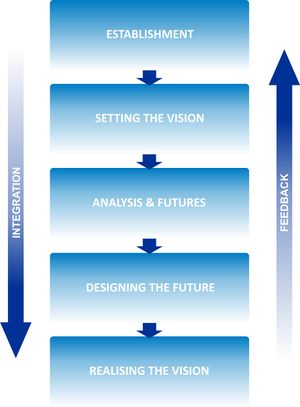ICZM Process diagram
| Introduction |
|
Establishment |
|
Analysis and Futures |
|
Setting the Vision |
|
Designing the Future |
|
Realising the Vision |
|
Welcome to the ICZM Process
The primary target audience for this ICZM Process are practitioners and partnerships tasked with the production of plans, strategies or ICZM programmes for coastal areas in the Mediterranean and Black Sea. It is hoped that the ICZM Process will also contribute to the wider global discussion on the sustainable development of coastal zones.
The design of the ICZM Process is being coordinated by Priority Actions Programme/Regional Activity Centre (PAP/RAC). PAP/RAC is a component organisation body of the Mediterranean Action Plan (MAP), part of the United Nations Environment Programme (UNEP). 21 Mediterranean countries and the European Union make up the MAP. One of six Regional Activity Centres within the MAP, the Centre has built up a global reputation due to its expertise in Integrated Coastal Zone Management (ICZM).
The ICZM Process is designed for guidance – adaption to individual local circumstances will dictate changes to this process within the overall framework - is structured into 5 sections representing the key stages of the ICZM Process.
Each stage is summarised into:
• Description of the stage
• Overall aim
• Likely outputs
Each stage then leads to a more detailed breakdown of the individual tasks, including:
• Tools & techniques • Integrative issues • Integrating climate change • Outputs of the detailed tasks • Examples
It is important to stress that the ICZM Process is designed not just to produce a plan or a strategy for a coastal area. In the end, a plan or strategy’s success or failure depends on its ability to catalyze change. This is what matters - not the specific process, nor the form of the strategy document, but whether or not it results in positive action
The ICZM Process - Overview
The ICZM Process is designed to deliver the "Four Orders of Outcome for ICZM". Olsen, S.B. (2003): Frameworks and indicators for assessing progress in integrated coastal management initiatives. Ocean & Coastal Management 46, 347-361.
The Four Orders provide a roadmap towards sustainable development and uderpin the approach to ICZM in the Mediterranean and Black Sea.
The First Order creates an enabling framework - creating the preconditions required to successfully implement the plan of action of an ICZM programme,
The Second Order analyses changes in behaviour that occur during implementation: changes in the behaviour of target user groups, changes in the behaviour of key institutions and changes in how and where financial investments are made. 1.3. The Third Order measures practical results and benefits. These Third Order Outcomes, e.g., improved water quality, justify financial investments and motivates the stakeholders and institutions to make the changes in their behaviour that sustained success requires.
The Third Order measures practical results and benefits. These Third Order Outcomes, e.g., improved water quality, justify financial investments and motivates the stakeholders and institutions to make the changes in their behaviour that sustained success requires.
The Fourth Order looks at the appropriate balance between environment and human society – sustainable development.
'Coastal issues are complex, but your strategy, your plan or your programme should not be; just remember that ICZM is as much a social as a technical process. Also, resources will always be limited. So here are a few practical tips to smooth your way:
• Keep it simple and fit for purpose - don’t over complicate
• Where possible, work with what you have, commission new work/research and data collection only where absolutely required
• Process should be adaptive to local circumstances and resources
• Communication is the key – enabling stakeholders to visualise the problems, potential futures, and to find solutions
• No ICZM process should be strictly linear; all stages are iterative and will overlap depending on individual workplans
• There is no substitute for full stakeholder participation.'''''
Brian Shipman PAP/RAC


